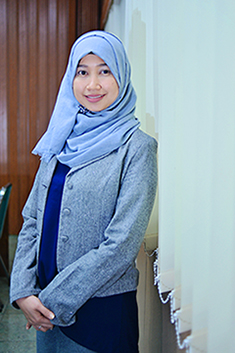Optimasi dan Validasi Metode KCKT untuk Identifikasi dan Penetapan Kadar Metabolit Nitrofuran dalam Bakso Udang
Downloads
Pendahuluan: Dikarenakan sifat dari Furazolidon, furaltadon, dan nitrofurantoin yang karsinogenik, perlu dilakukan pengawasan terhadap cemaran metabolit nitrofuran dalam produk berbahan dasar udang. Nitrofuran dimetabolisme secara cepat dalam jaringan tubuh hewan. Tujuan: Penelitian ini bertujuan melakukan validasi metode KCKT untuk penetapan kadar metabolit nitrofuran dalam bakso udang. Metode: Metabolit furazolidone, furaltadone dan nitrofurantoin yaitu 3-amino-2-oxazolidinone (AOZ), 3-amino-5-methylmorpholino-2-oxazolidinone (AMOZ), dan 1-aminohydantoin (AHD) diderivatisasi menggunakan 2-nitrobenzaldehida, diekstraksi dalam etil asetat dan dicuci dengan n-heksana, kemudian disuntikkan ke dalam system KCKT dengan detektor UV-PDA. Pemisahan dilakukan dengan kolom C-18 46 x 250 mm, 5 mm. Sebagai fase gerak adalah ammonium asetat 20 mM : asetonitril (70:30), dengan laju alir 0.5 mL/menit, suhu kolom 40oC, dan volume injeksi 100 µL. Hasil: Metode yang digunakan dapat memisahkan semua metabolit dari senyawa pengotor dengan waktu analisis 40 menit, dan menghasilkan linieritas yang baik dalam rentang konsentrasi 51,90 – 103,79 ng/mL (AOZ); 56,63 - 101,39 ng/mL (AMOZ); dan 49,92 - 89,86 ng/mL (AHD). Akurasi metode dipresentasikan sebagai rekoveri dengan hasil sebesar 78,50 - 102,29% untuk AOZ; 77,02 - 99,87% untuk AMOZ; and 85,54 - 99,77% untuk AHD. Presisi metode dinyatakan dalam simpangan baku relatif (relative standard deviation, RSD) dengan hasil masing-masing adalah 6,10 - 19,90%; 3,68 - 17,75%; and 2,75 - 12,58%untuk AOZ, AMOZ, dan AHD. LOD dan LOQ sebesar 3,09 ng/mL dan 10,29 ng/mL (AOZ); 6,84 ng/mL dan 22,82 ng/mL (AMOZ); serta 4,61 ng/mL dan 15,36 ng/mL (AHD). Kesimpulan: Metode uji dapat digunakan untuk skrining awal untuk mendeteksi dan penetapan kadar cemaran metabolit nitrofuran pada bakso udang.
Aldeek, F., Hsieh, K. C., Ugochukwu, O. N., Gerard, G. & Hammack, W. (2018). Accurate Quantitation and Analysis of Nitrofuran Metabolites, Chloramphenicol, and Florfenicol in Seafood by Ultrahigh-Performance Liquid Chromatography-Tandem Mass Spectrometry: Method Validation and Regulatory Samples [Research-article]. Journal of Agricultural and Food Chemistry; 66; 5018–5030.
Alkan, F., Kotan, A. & Ozdemir, N. (2016). Development and Validation of Confirmatory Method for Analysis of Nitrofuran Metabolites in Milk, Honey, Poultry Meat and Fish by Liquid Chromatography-Mass Spectrometry. Macedonian Veterinary Review; 39; 15–22.
AOAC. (2016). Appendix F: Guidelines for Standard Method Performance Requirements. Rockville: AOAC International.
Aydin, S. (2015). A Short History, Principles, and Types of ELISA, and Our Laboratory Experience with Peptide/Protein Analyses Using ELISA. Peptides; 72; 4–15.
European Comission. (2007). The Rapid Alert System for Food and Feed (RASFF) Annual Report 2007. Luxembourg: Office for Official Publications of the European Communities.
Fernando, R., Munasinghe, D. M. S., Gunasena, A. R. C. & Abeynayake, P. (2017). Determination of Nitrofuran Metabolites in Shrimp Muscle by Liquid Chromatography-Photo Diode Array Detection. Food Control; 72; 300–305.
Kaufmann, A., Butcher, P., Maden, K., Walker, S. & Widmer, M. (2015). Determination of Nitrofuran and Chloramphenicol Residues by High Resolution Mass Spectrometry Versus Tandem Quadrupole Mass Spectrometry. Analytica Chimica Acta; 862; 41–52.
Khong, S. P., Gremaud, E., Richoz, J., Delatour, T., Guy, P. A., Stadler, R. H. & Mottier, P. (2004). Analysis of Matrix-Bound Nitrofuran Residues in Worldwide-Originated Honeys by Isotope Dilution High-Performance Liquid Chromatography-Tandem Mass Spectrometry. Journal of Agricultural and Food Chemistry; 52; 5309–5315.
Prihanani, N. I., Nugroho, W. S. & Wijayanti, A. D. (2017). Analisis Residu 3-amino-2-oxazolidinone (AOZ) pada Hati dan Otot Dada Ayam Setelah Proses Pemanasan menggunakan Metode Kromatografi Cair Kinerja Tinggi (KCKT). Tesis; Fakultas Kedokteran Hewan Universitas Gadjah Mada, Yogyakarta.
Shabir, G. A. (2003). Validation of High-Performance Liquid Chromatography Methods for Pharmaceutical Analysis. Journal of Chromatography A; 987; 57–66.
Vass, M., Hruska, K. & Franek, M. (2008). Nitrofuran Antibiotics: A Review on the Application, Prohibition and Residual Analysis. Veterinarni Medicina; 53; 469–500.
Verdon, E., Couedor, P. & Sanders, P. (2007). Multi-Residue Monitoring for the Simultaneous Determination of Five Nitrofurans (Furazolidone, Furaltadone, Nitrofurazone, Nitrofurantoine, Nifursol) in Poultry Muscle Tissue Through the Detection of Their Five Major Metabolites (AOZ, AMOZ, SEM, AHD, DNSA. Analytica Chimica Acta; 586; 336–347.
Yuwono, M., & Indrayanto, G. (2005). Validation of Chromatographic Methods of Analysis. Profiles of Drug Substances, Excipients and Related Methodology; 32; 241–260.
1. The copyright of this journal belongs to the Editorial Board and Journal Manager with the author's knowledge, while the moral right of the publication belong to the author.
2. The formal legal aspect of journal publication accessibility refers to the Creative Commons Attribution-Non-Commercial-Share Alike (CC BY-NC-SA), which implies that the publication can be used for non-commercial purposes in its original form.
3. Every publication (print/electronic) is open access for educational, research, and library purposes. In addition to the objectives mentioned above, the editorial board is not responsible for copyright infringement


.jpg)















